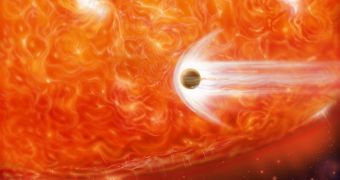Another planet has been discovered outside the boundaries of our solar system. A team of astronomers came upon the planet while performing observations with the Hobby-Eberly Telescope of McDonald Observatory in Texas. Actually, they did not observe the planet directly, but rather deduced it was there by using the radial velocity method that relies on the measurements of a star's faint wobbles determined by the gravitational tug of a planet orbiting around it.
This planet is believed to be about six times Jupiter's mass and it revolves around the swallowing red giant star called HD 102272, found some 1,200 light years far, in the Leo constellation, one of only 20 such stars discovered so far that are able to support planets. The experts think there could even be another planet with a larger orbit around HD 102272, which would make it the first known red giant having more than an orbiting planet.
"When red-giant stars expand, they tend to eat up the nearby planets," explained researcher Alexander Wolszczan, an astrophysicist at Penn State, for Space. "There appears to be a zone of avoidance around such stars of about 0.6 astronomical units." The team thinks this could be the maximal closeness limit that a planet can reach reported to its star before being utterly vaporized.
For now, HD 102272 is only ten times larger than the Sun, but it will quickly grow to 100 times the Sun's size, in about 100 million years, then, there will be no escape. While this planet may be lost, another distant one, now frozen, may thaw to provide a life-supporting environment. This scenario could apply to our solar system as well in about 5 billion years, when Jupiter's moon Europa "may become a very pleasant, nice ocean world," shared Wolszczan. "There would still be more than a billion years of time for life to develop again somewhere else in the solar system, even though at this point it is not quite possible."

 14 DAY TRIAL //
14 DAY TRIAL //